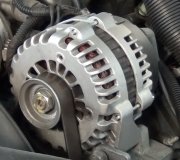Also, the results of the test are inaccurate:
No Load 12.00V -19.9A
Loaded 11.58V -61.1A
The voltage can not be allowed to drop below 13.75 volts. If it does, the person is trying to draw too much current and is loading the system down too much. That 11.58 volts is what also creates the current that creates the rotating electromagnet, and if the voltage is low, the strength of the magnet will be low, and there's no way you'll get the maximum output. These numbers suggest the alternator is working, just not at its design rating. That can also be caused by a test bench that is not running the alternator fast enough. It takes a good five horsepower to run them wide open.
Wrenchtech is right; the voltage regulator is inside the Engine Computer. These Nippendenso alternators have a common problem with worn brushes, and that always causes intermittent charging for weeks or months before they fail completely. That's why testing it at two different times results in two different results. The brush assembly costs $9.00. It can be replaced without removing the alternator from the engine on '95 and older models. I never tried to do that on the miserable redesigned '96 and newer ones, but from looking at them I would assume the alternator would have to be removed.
To verify if I'm right about the brushes, measure the voltages on the two smaller wires while the engine is running AND while the no-charge condition is occurring. You will find full battery voltage on one. The other one must have less but not 0 volts. 4-11 volts is typical. If you find 0 volts, replace the brushes. If you find exactly the same voltage on both wires, (near 12 volts), there's a break in the wire going to the regulator in the computer, or the voltage regulator circuit is defective. A defective regulator circuit is rare. If you find close to 0 volts on both wires I'd suspect your voltmeter probes aren't making good contact. To really have that there is only a foot of wire and one splice that can be bad. That entire circuit also feeds the ignition coil(s) and injectors so a problem before that splice would result in a no-start condition.
In case no one mentioned it yet, a lot of people lately seem to be confused by that battery warning light on the dash. That has nothing to do with the condition of the battery. It means the charging system isn't recharging the battery while you're driving, and system voltage is too low. While the old battery could very well have been bad, that alone won't turn the warning light on.
The negative signs on your test result numbers can be ignored. That just means the clip-on inductive pickup probe was turned around on the wire. It's the value that is important.
An alternator can have one defective internal diode too out of the six. That will reduce the maximum output to exactly one third of its design current rating, so you would have only been able to get around 40-45 amps under full load. There are only three output current values you can get. 0 amps means a definite defect, typically those brushes. The design rating means it's working properly, at least at this time. One third of its rating means a defective diode. While they can be replaced, due to the cost of the assembly and the labor time involved, we don't do that. To insure a quality repair we install a rebuilt alternator with a warranty.
You got around half of the design rating during the test, and the only way that can happen is improper test procedures. In your case the voltage was too low, but it's also likely the speed was too low. During on-car testing, part of the procedure always includes raising engine speed, normally to around 2000 rpm. Many automatic testers won't even start the test until they detect that engine speed. You need three things to generate an output from an alternator, a coil of wire, a magnet, and movement between them. Can't do anything about the coil of wire; that's a given, but reduce the strength of the magnet, (voltage is too low), or reduce the speed of that movement, and there's no way you'll get the full output.
Saturday, October 13th, 2012 AT 1:28 AM



